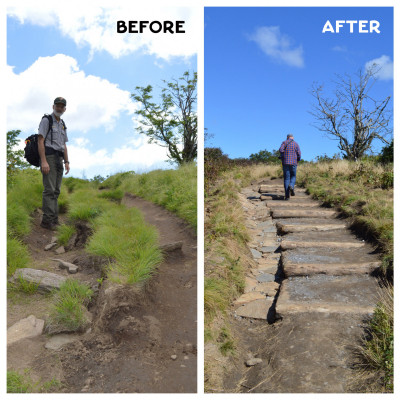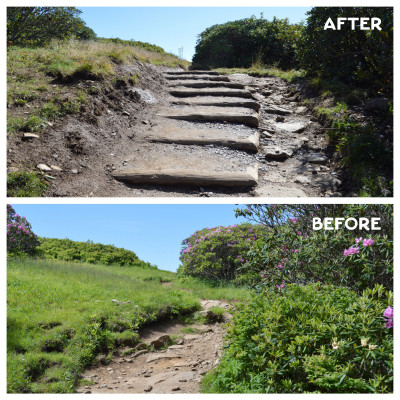 You did it! Thanks to you, we exceeded the “I Love Craggy” Matching Challenge! You donated $6,195 to match $5,497 from RomanticAsheville.com. That’s a total of $11,692 to repair the Craggy Bald Trail and create new exhibits at the Visitor Center. We want to offer a special thanks to RomanticAsheville.com for the founding match that got the challenge off the ground (and out on the trail).
You did it! Thanks to you, we exceeded the “I Love Craggy” Matching Challenge! You donated $6,195 to match $5,497 from RomanticAsheville.com. That’s a total of $11,692 to repair the Craggy Bald Trail and create new exhibits at the Visitor Center. We want to offer a special thanks to RomanticAsheville.com for the founding match that got the challenge off the ground (and out on the trail).
A crew with the American Conservation Experience has just finished most of the repairs at Craggy Flats Bald Trail during a four-week stint. Their work included creating new steps for easier trekking, filling in braided trails that contributed to erosion on the bald, removing encroaching vegetation, and building runoff areas to keep water from turning the trail into a stream. The trail work extends from the historic shelter built by the Civilian Conservation Corps in 1937 to the top of the bald.
“Craggy Gardens has been one of my favorite places to explore since I was a child,” says Mark File, owner of RomanticAsheville.com. “I hope this project ensures that many future generations will be inspired by this magical place.”
 The hike to Craggy Flats Bald, accessible from the picnic area and Visitor Center, is a popular trail on the Blue Ridge Parkway, particularly in June when rhododendrons are in bloom. Heavy visitation had taken a toll on the trail, leading to erosion areas as deep as two-feet and damage to the habitat. Because the trail was so degraded, it is also difficult for National Park Service staff to access the area with the equipment needed to maintain the bald, which served as a grazing area for livestock before the construction of the Blue Ridge Parkway. The rare plants, wildlife, habitats, and natural features found here make it a designated North Carolina Natural Heritage Area.
The hike to Craggy Flats Bald, accessible from the picnic area and Visitor Center, is a popular trail on the Blue Ridge Parkway, particularly in June when rhododendrons are in bloom. Heavy visitation had taken a toll on the trail, leading to erosion areas as deep as two-feet and damage to the habitat. Because the trail was so degraded, it is also difficult for National Park Service staff to access the area with the equipment needed to maintain the bald, which served as a grazing area for livestock before the construction of the Blue Ridge Parkway. The rare plants, wildlife, habitats, and natural features found here make it a designated North Carolina Natural Heritage Area.
The Craggy Gardens Visitor Center, milepost 364.5, hosts 85,000 visitors annually. Inside the circa-1952 building, the 10-year-old faded and outdated exhibit panels will be replaced by displays that tell the story of the plants and animals in this unique and harsh high elevation environment. The work will be accomplished in two phases with the main exhibits slated for installation in late fall of this year. David Williams of Wingin’ It Works is collaborating with the National Park Service to design the interpretive panels.





